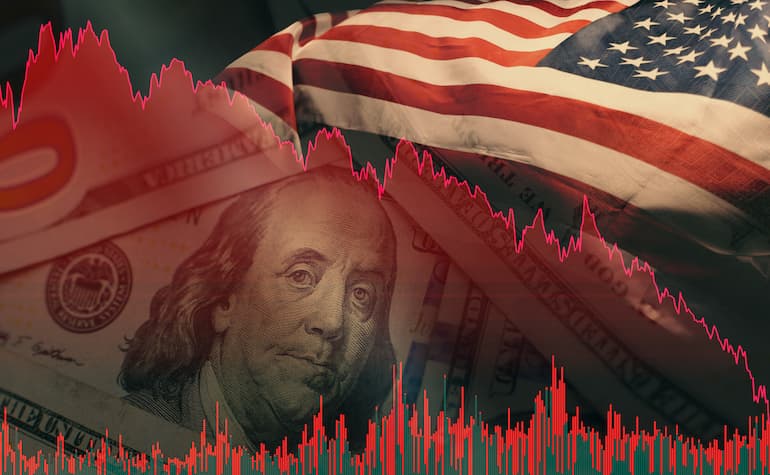Noticias del mercado & perspectivas
Anticípate a los mercados con perspectivas de expertos, noticias y análisis técnico para guiar tus decisiones de trading.

Multi-Timeframe (MTF) analysis is not just about checking the trend on the daily before trading on the hourly; ideally, it involves examining and aligning context, structure, and timing so that every trade is placed with purpose.
When done correctly, MTF analysis can filter market noise, may help with timing of entry, and assist you in trading with the trending “tide,” not against it.
Why Multi-Timeframe Analysis Matters
Every setup exists within a larger market story, and that story may often define the probability of a successful trade outcome.
Single-timeframe trading leads to the trading equivalent of tunnel vision, where the series of candles in front of you dominate your thinking, even though the broader trend might be shifting.
The most common reason traders may struggle is a false confidence based on a belief they are applying MTF analysis, but in truth, it’s often an ad-hoc, glance, not a structured process.
When signals conflict, doubt creeps in, and traders hesitate, entering too late or exiting too early.
A systematic MTF process restores clarity, allowing you to execute with more conviction and consistency, potentially offering improved trading outcomes and providing some objective evidence as to how well your system is working.
Building Your Timeframe Hierarchy
Like many effective trading approaches, the foundation of a good MTF framework lies in simplicity. The more complex an approach, the less likely it is to be followed fully and the more likely it may impede a potential opportunity.
Three timeframes are usually enough to capture the full picture without cluttering up your chart’s technical picture with enough information to avoid potential contradiction in action.
Each timeframe tells a different part of the story — you want the whole book, not just a single chapter.

Scalpers might work on H1-M15-M5, while longer-term traders might prefer H4-H1-H15.
The key is consistency in approach to build a critical mass of trades that can provide evidence for evaluation.
When all three timeframes align, the probability of at least an initial move in your desired direction may increase.
An MTF breakout will attract traders whose preference for primary timeframe may be M15 AND hourly, AND 4-hourly, so increasing potential momentum in the move simply because more traders are looking at the same breakout than if it occurred on a single timeframe only.
Applying MTF Analysis
A robust system is built on clear, unambiguous statements within your trading plan.
Ideally, you should define what each timeframe contributes to your decision-making process:
- Trend confirmed
- Structure validated
- Entry trigger aligned
- Risk parameters clear
When you enter on a lower timeframe, you are gaining some conviction from the higher one. Use the lower timeframe for fine-tuning and risk control, but if the higher timeframe flips direction, your bias must flip too.
Your original trading idea can be questioned and a decision made accordingly as to whether it is a good decision to stay in the trade or, as a minimum action, trail a stop loss to lock in any gains made to date.
Putting MTF into Action
So, if the goal is to embed MTF logic into your trade decisions, some step-by-step guidance may be useful on how to make this happen
1. Define Your Timeframe Stack
Decide which three timeframes form your trading style-aligned approach.
The key here is that as a starting point, you must “plant your flag” in one set, stick to it and measure to see how well or otherwise it works.
Through doing this, you can refine based on evidence in the future.
One tip I have heard some traders suggest is that the middle timeframe should be at least two times your primary timeframe, and the slowest timeframe at least four times.
2. Build and Use a Checklist
Codify your MTF logic into a repeatable routine of questions to ask, particularly in the early stages of implementing this as you develop your new habit.
Your checklist might include:
- Is the higher-timeframe trend aligned?
- Is the structure supportive?
- Do I have a valid trigger?
- Is risk clearly defined?
This turns MTF from a concept into a practical set of steps that are clear and easy to action.
3. Consider Integrating MTF Into Open Trade Management
MTF isn’t just for entries; it can also be used as part of your exit decision-making.
If your higher timeframe begins showing early signs of reversal, that’s a prompt to exit altogether, scale out through a partial close or tighten stops.
By managing trades through the same multi-timeframe approach that you used to enter, you maintain logical consistency across the entire lifecycle of the trade.
Final Action
Start small. Choose one instrument, one timeframe set, and one strategy to apply it to.
Observe the clarity it adds to your decisions and outcomes. Once you see a positive impact, you have evidence that it may be worth rolling out across other trading strategies you use in your portfolio.
Final Thought
Multi-Timeframe Analysis is not a trading strategy on its own. It is a worthwhile consideration in ALL strategies.
It offers a wider lens through which you see the market’s true structure and potential strength of conviction.
Through aligning context, structure, and execution, you move from chasing an individual group of candles to trading with a more robust support for a decision.


One of the most anticipated earnings releases in the calendar is here. NVIDIA Corporation (NASDAQ: NVDA) announced the latest results after the closing bell on Tuesday. Let’s see how one of the companies from the ''trillion club'' performed.
Company overview Founded: 5/4/1993 Headquarters: Santa Clara, California, United States Number of employees: 26,196 (2023) Industry: Computer hardware, computer software, cloud computing, semiconductors, artificial intelligence, GPUs Graphics cards Consumer electronics Video games Key people: Jensen Huang (President and CEO) The results NVIDIA reported revenue that beat Wall Street estimates at $18.12 billion for the third quarter fiscal 2024 vs. $16.12 billion expected. Revenues were up by 205% year-over-year. Earnings per share also beat estimates at $4.02 per share (up by 48.88% year-over-year) vs. $3.367 per share expected.
The company expects revenue of around $20 billion for the fourth quarter. CEO commentary "Our strong growth reflects the broad industry platform transition from general-purpose to accelerated computing and generative AI," Jensen Huang, CEO of NVIDIA said in a letter to investors. "Large language model startups, consumer internet companies and global cloud service providers were the first movers, and the next waves are starting to build. Nations and regional CSPs are investing in AI clouds to serve local demand, enterprise software companies are adding AI copilots and assistants to their platforms, and enterprises are creating custom AI to automate the world’s largest industries.
NVIDIA GPUs, CPUs, networking, AI foundry services and NVIDIA AI Enterprise software are all growth engines in full throttle. The era of generative AI is taking off," Huang highlighted how the world is adapting to and embracing AI. Stock reaction The stock was down by 0.92% at $499.44 a share before the results were announced.
Share price fell by around 1% in the after-hours trading as the market digested the latest results. Stock performance 1 month: +14.39% 3 months: +9.36% Year-to-date: +241.75% 1 year: +211.41% NVIDIA stock price targets Stifel: $600 Piper Sandler: $620 Wedbush: $600 Bernstein: $675 Keybanc: $650 Morgan Stanley: $600 Citigroup: $575 Truist Securities: $668 Jefferies: $610 TD Cowen: $600 NVIDIA Corporation is the 6th largest company in the world with a market cap of $1.233 trillion. You can trade NVIDIA Corporation (NASDAQ: NVDA) and many other stocks from the NYSE, NASDAQ, HKEX, ASX, LSE and DE with GO Markets as a Share CFD.
GO Markets now offers pre-market and after-market trading on popular US Share CFDs. Trade the pre-market session: 4:00am to 9:30am, normal session, and after-market session: 4:00pm to 8:00pm, Eastern Standard Time. Why trade during extended hours?
Volatility never sleeps. Trade over earnings releases as they happen outside of main trading hours Reduce your risk and hedge your existing positions ahead of a new trading day Extended trading hours on popular US stocks means extended opportunities Sources: NVIDIA Corporation, TradingView, MarketWatch, Benzinga, CompaniesMarketCap


Micron Technology Inc. (NASDAQ: MU) released first quarter of fiscal 2024 earnings results after the market close in the US on Wednesday. US semiconductor company reported revenue of $4.726 billion, which was above Wall Street analyst estimate of $4.581 billion. Earnings per share (EPS) reported loss per share of -$0.95 for the quarter vs. -$1.005 loss per share expected.
Company overview Founded: October 5, 1978 Headquarters: Boise, Idaho, United States Number of employees: Robert E. Switz (Chairman), Sanjay Mehrotra (President & CEO) Industry: Semiconductors Key people: 43,000 (2023) CEO commentary "Micron’s strong execution and pricing drove better-than-anticipated first quarter financial results," Sanjay Mehrotra, CEO of the company said in a press release. "We expect our business fundamentals to improve throughout 2024, with record industry TAM projected for calendar 2025. Our industry-leading High Bandwidth Memory for data center AI applications illustrates the strength of our technology and product roadmaps, and we are well positioned to capitalize on the immense opportunities artificial intelligence is fueling across end markets," Mehrotra looked at what’s ahead for Micron.
Stock reaction The stock was down by 4.24% at the end of trading on Wednesday at $78.69 a share. Shares rose by around 4% after Micron topped analyst estimates for the quarter. Stock performance 1 month: +2.13% 3 months: +13% Year-to-date: +57.54% 1 year: +53.82% Micron Technology stock price targets Rosenblatt Securities: $100 BMO Capital Markets: $90 TD Cowen: $100 Susquehanna: $112 Stifel Nicolaus: $76 Bank of America: $95 UBS Group: $90 Mizuho: $86 Citigroup: $88 Barclays: $85 Morgan Stanley: $71.50 JP Morgan: $80 Micron Technology Inc. is the 168th largest company in the world with a market cap of $86.86 billion.
You can trade Micron Technology Inc. (NASDAQ: MU) and many other stocks from the NYSE, NASDAQ, HKEX and ASX with GO Markets as a Share CFD. GO Markets now offers pre-market and after-market trading on popular US Share CFDs. Trade the pre-market session: 4:00am to 9:30am, normal session, and after-market session: 4:00pm to 8:00pm, Eastern Standard Time.
Why trade during extended hours? Volatility never sleeps. Trade over earnings releases as they happen outside of main trading hours Reduce your risk and hedge your existing positions ahead of a new trading day Extended trading hours on popular US stocks means extended opportunities Sources: Micron Technology Inc., TradingView, MarketWatch, Benzinga, CompaniesMarketCap


One of the largest food retailers in the United States, Kroger Co. (NYSE: KR), announced Q3 earnings results before the opening bell in Wall Street on Thursday. Company overview Founded: 1883 Headquarters: Cincinnati, Ohio, United States Number of employees: 465,000 (2022) Industry: Retail Key people: Rodney McMullen (CEO & Chairman) The results Korger reported revenue of $33.957 billion for the quarter, narrowly beating analyst estimate of $33.903 billion. Earnings per share reported at $0.95 per share vs. $0.907 per share expected.
CEO commentary Rodney McMullen, CEO of the company had this to say in the letter to investors after the release of Q3 results: "Kroger's third quarter results highlight the strength and diversity of our business model in a challenged operating environment, as strong fuel performance and growth in our alternative profit businesses supported continued adjusted net earnings per diluted share growth. As consumer spending tightens, we are focused on providing customers with exceptional value. By maintaining our long-term commitment to lower prices, personalised promotions and rewards, we are growing households and increasing loyalty, positioning Kroger for sustainable future growth.
We appreciate our associates and continue to invest in wages, benefits and training, which is resulting in continued improvements in our customer experience. "Our model's strength allows us to navigate many economic environments. We remain committed to balancing investments in associates and greater value for our customers while continuing to generate attractive and sustainable returns for our shareholders," McMullen highlighted the importance of the companies strategy to continue deliver solid results in the future. Stock reaction The stock had a positive reaction following the Q3 results announcement.
Shares were up by just over 2% at $44.59 a share. Stock performance 1 month: -1.59% 3 months: -3.69% Year-to-date: +0.22% 1 year: -7.71% Kroger stock price targets Telsey Advisory Group: $44.88 Roth MKM: $48 Deutsche Bank: $50 Bernstein: $54 BMO Capital: $45 Northcoast Research: $60 Kroger Co. is the 549th largest company in the world with a market cap of $32.29 billion. You can trade Kroger Co. (NYSE: KR) and many other stocks from the NYSE, NASDAQ, HKEX, ASX, LSE and DE with GO Markets as a Share CFD.
GO Markets now offers pre-market and after-market trading on popular US Share CFDs. Trade the pre-market session: 4:00am to 9:30am, normal session, and after-market session: 4:00pm to 8:00pm, Eastern Standard Time. Why trade during extended hours?
Volatility never sleeps. Trade over earnings releases as they happen outside of main trading hours Reduce your risk and hedge your existing positions ahead of a new trading day Extended trading hours on popular US stocks means extended opportunities Sources: Kroger Co., TradingView, MarketWatch, TipRanks, Benzinga, CompaniesMarketCap, FactSet


US business software company Intuit Inc. (NASDAQ: INTU) announced the latest financial results for first quarter of fiscal 2024 after the closing bell in the US on Tuesday. Company overview Founded: 1983 Headquarters: Mountain View, California, United States Number of employees: 18,200 (2023) Industry: Enterprise software Key people: Sasan Goodarzi (CEO), Scott Cook (Chairman) The results Intuit reported revenue of $2.978 billion for the three months ending October 31 st (up by 15% from the same period last year), which was above analyst estimate of $2.878 billion. Earnings per share also topped analyst estimates at $2.47 per share (up by 49% year-over-year) vs. $1.978 per share expected.
The company reiterated full fiscal year 2024 revenue guidance of between $15.890 billion to $16.105 billion, which would represent growth of between 11% to 12% year-over-year. CEO commentary "We had a very strong first quarter, starting our fiscal year with momentum," CEO of Intuit, Sasan Goodarzi said in a letter to investors. "With data and AI core to our strategy, we're accelerating innovation across our global financial technology platform to power the prosperity of consumers and small businesses," Goodarzi added. Stock reaction The stock was up by 0.68% at $565.07 a share on Tuesday.
Share rose by around 1% in the after-hours trading as the latest results were announced. Stock performance 1 month: +14.17% 3 months: +5.33% Year-to-date: +45.18% 1 year: +48.82% Intuit stock price targets Wells Fargo: $575 Bank of America: $580 Morgan Stanley: $525 KeyBanc: $600 JP Morgan: $563 Intuit Inc. is the 71 st largest company in the world with a market cap of $158.18 billion. You can trade Intuit Inc. (NASDAQ: INTU) and many other stocks from the NYSE, NASDAQ, HKEX, ASX, LSE and DE with GO Markets as a Share CFD.
GO Markets now offers pre-market and after-market trading on popular US Share CFDs. Trade the pre-market session: 4:00am to 9:30am, normal session, and after-market session: 4:00pm to 8:00pm, Eastern Standard Time. Why trade during extended hours?
Volatility never sleeps. Trade over earnings releases as they happen outside of main trading hours Reduce your risk and hedge your existing positions ahead of a new trading day Extended trading hours on popular US stocks means extended opportunities Sources: Intuit Inc., TradingView, MarketWatch, TipRanks, Benzinga, CompaniesMarketCap, FactSet


USD – The US dollar index was ultimately firmer in a choppy session where DXY hit a low of 103.18 in the APAC session only to reverse course later hitting a high of 103.71 in the US session. A sour risk environment after some misses in US retail earnings and traders getting long before the FOMC minutes seem to be the key drivers. Reaction to the minutes ended up being muted with a slight pop that retraced in quick time.
DXY now sandwiched between its 200-day SMA and key support level at 103.60 heading into the APAC session. AUD – AUDUSD got off to a flier in the APAC session after what was seen as hawkish RBA minutes released early in the session. The Aussie did fade later as it failed to breach key technical resistance at the 200-day SMA at 0.6590 and finished the session flat.
Key levels to watch today will be 0.6524 to the downside which was the top end of its recent range and the aforementioned 200-day SMA to the upside, Aussie traders will have comments from Governor Bullock later today to watch out for. EUR GBP EUR was the G10 laggard with EURUSD hitting a low of 1.0901 before finding some support at the big figure. ECB president Lagarde did speak but failed to inspire the bulls, also some budgetary issue out of Germany weighed on the single currency.
GBP on the other hand outperformed with cable having a positive session after some hawkish commentary from the BoE. This saw a sharp drop in EURGBP from its resistance at 0.8750 and heading towards its lower trend line support. Gold – XAUUSD broke out, setting new November highs and testing the October highs at 2009 before finding some resistance.
This came despite a stronger USD on the session, which would cheer the gold bulls.


USD continued its recent decline on Tuesday with the US dollar index (DXY) hitting its lowest level since mid-August at 102.60 before finding some support at the 61.8 Fib level. The decline accelerated after voting Fed member Waller who is seen as a hawk, made some dovish remarks regarding rates and inflation namely he was “increasingly confident" policy is well positioned to slow the economy and get inflation back to 2%, he also hinted at rate cuts next year if inflation and the economy continued on its current path. There were also some comments from Fed member Bowman which skewed hawkish, but as she is already considered a hawk there wasn’t a comparable market reaction as to the Waller comments.
Chart Source:TradingView.com JPY was the G10 outperformer benefitting the most from USD weakness and lower US Treasury yields that saw the US 10 year and JGB 10-year yields compress further. USDJPY hitting a low of 147.32 and testing the November lows and support level at 147.27. Today the BoJ's Adachi is due to speak ahead of a raft of Japanese data released during the remainder of the week.
Chart Source:TradingView.com AUDUSD and NZDUSD both hit 3-month highs of 0.6665 and 0.6147 respectively, with broad USD weakness and a risk-on market supporting both cyclical currencies. Strength in the commodity markets and recent hawkish comments from RBA governor Bullock also lending a tailwind to AUD. Both currencies come into Wednesday with key economic readings to navigate, with Aussie CPI, where a drop to 5.2% Y/Y from 5.6% is expected, and a RBNZ rate decision due.
The RBNZ is widely expected to hold rates at 5.50% so it will be the forward guidance kiwi traders will be watching closely. Chart Source:TradingView.com

